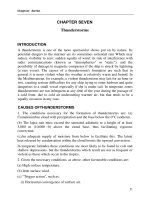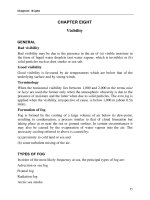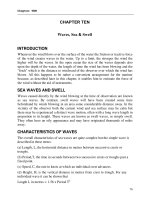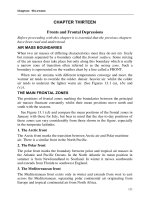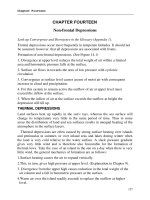BÀI GIẢNG KHÍ TƯỢNG LÝ THUYẾT CHƯƠNG 25
Bạn đang xem bản rút gọn của tài liệu. Xem và tải ngay bản đầy đủ của tài liệu tại đây (44.78 KB, 5 trang )
Chapter Twenty Five
CHAPTER TWENTY FIVE
Brief Notes on Observations and Instruments
The importance of being weather conscious
Observing the weather is an essential part of the duties of a deck officer; in fact
he is no seaman if he is not weather-conscious. for when on watch a part of his
task of keeping a good lookout is to note and record changes in wind, sea,
cloud, visibility, etc. In a sailing ship and any small craft, safety and progress
depend almost entirely upon the wind and weather: the same is true but to a
lesser degree aboard a power driven ship. It is no exaggeration to say that
observing and recording the weather, and the intelligent use of simple
meteorological instruments is a part of seamanship.
The making of both instrumental and non-instrumental observations and
recording them at least every four hours in the ship's log book (and at the times
of any significant changes) are a normal part of an officer's watch-keeping
duties.
NON-INSTRUMENTAL OBSERVATIONS include:
Direction and force of wind.
Direction and description of swell (no swell should also be recorded).
Visibility.
Weather in general terms; e.g. fine, moderate rain, hail, etc.
State of sky; e.g., blue sky, cloudy, overcast, etc.
If the ship is taking spray or shipping . 'green seas".
Behaviour of ship; e.g., rolling heavily, pitching, pounding, engines racing. In
merchant ships observations of wind direction and force, state of sea, swell and
visibility are all estimated.
INSTRUMENTAL OBSERVATIONS for ship's log book include:
Barometric pressure reduced to sea level. The correction for diurnal variation is
only applied to readings of barometric pressure for the Master's operational use
and so this correction should not be applied to the reading recorded in the
ship's log book.
219
Chapter Twenty Five
Air temperature
Sea surface temperature. The method of obtaining the sea surface temperature
should also be recorded.
OBSERVATIONS BY SELECTED SHIPS
If the vessel is a selected ship under the WMO voluntary observing scheme
more detailed observations are made and then coded for transmission. The
message is coded using an international code, details of which appear in the
Ship's Code and Decode Book MET. O. 509.
Selected ships' reports include barometric pressure. barometric tendency, air
temperature, dew-point (determined by table from hygrometer readings) and
temperature of the sea surface. for all of which special instruments are supplied
on loan to the ship by the Port Meteorological Officer. In a few selected ships
distant reading instruments are supplied and tined for all temperature readings.
the recorders being sited on the bridge.
SUMMARY OF POINTS TO REMEMBER WHEN READING A BAROMETER
(A) Aneroid barometer. Tap gently. read, record and check. Correct only for
Index Error and height.
(B) Precision aneroid barometer. Correct only for height.
The correction table for height above sea level is entered with arguments height
and temperature of the outside air. NOT the temperature inside the chart room.
AN APPROXIMATE HEIGHT CORRECTION FOR ANEROID BAROMETER
Hectopascals: Height in feet above sea level increased by 10 per cent and
divided by 30 gives correction in hectopascals to be added.
BAROGRAPH
A barograph is supplied by the Meteorological Office to each Selected Ship. It
produces a continuous graphical record of barometric pressure on a chart called
a barogram Thus it shows all fluctuations in pressure which occur between the
fixed times at which the barometer is read.
It consists of a series of flat circular sealed metal boxes which are partially
exhausted of air and are very sensitive to small changes in atmospheric
pressure. which either increase or decrease the volume of the boxes. These
movements are transmitted by an arrangement of levers to vertical movement
of a pen arm. The pen draws an ink trace on the barogram which is fitted round
220
Chapter Twenty Five
a revolving drum. The drum revolves about a vertical axis controlled by a
clock. and one revolution takes one week, during which time a continuous
record of all pressure variations are shown against GMT and date. The
barogram is renewed every week when the clock is rewound.
The instrument is contained in a glass case with a hinged lid for winding
the clock, renewing the graph, refilling the inkwell, etc.
The barometric tendencies read from the barogram are recorded in the
meteorological logbook and included in the coded weather reports for
synoptic hours, The barograph should be kept at Greenwich date and time
throughout the voyage .
HYGROMETER
The hygrometer is an instrument for measuring the humidity of the air. The
type most commonly used aboard ship (Mason’s Hygrometer) consists of
two ordinary thermometers mounted vertically inside a wooden box
(Stevenson's Screen) which is louvred on all four sides to protect the inside
from rain and sun. also to allow air to now freely through the box.
The thermometers are exactly the same but one is “dry" and is used for
finding the air temperature, the other (the "wet" bulb) has the bulb wrapped
in a single thickness of muslin, secured round the neck of the bulb by a few
strands of cotton wick, the lower ends of which are immersed in a small
reservoir of distilled water placed in the screen; thus the wet bulb is kept
moist by capillary action.
Principle. The lower the humidity of the air (and hence the drier the air) the
faster the evaporation from the muslin on the wet bulb, hence the lower the
wet bulb temperature compared with that of the dry bulb, Conversely. when
humidity is high the rate of evaporation is slow and the difference in
readings between the two thermometers, called "the depression of the wet
bulb". is very little.
The accuracy of the readings depends on the flow of air past the
thermometers. so the screen should be exposed on the weather side of the
bridge, well clear of warm air currents from deck, funnel, ventilators, skylights. etc.
The data derived from the readings of the dry and wet bulb thermometers
are the relative humidity and dew-point which are obtained from tables
supplied with the instrument.
221
Chapter Twenty Five
SEA THERMOMETERS
The sea surface temperature is an important observation for the
meteorologist, as it is used for climatological work as well as for shorter term
forecasting. A knowledge of the sea temperature is also useful to the
shipmaster. It must be considered in controlling cargo ventilation and can
assist in forecasting the onset of advection fog.
WIND FORCE AND DIRECTION
Although some vessels are fitted with anemometers for measuring the wind
speed these are difficult to site on a vessel as they should be kept clear of all
obstructions. The motion of the vessel also affects their readings. The general
method used is to observe the appearance of the sea surface. This is then
compared with a detailed description of the probable state of the sea caused
by winds of various forces as given in the Beaufort Scale. This sea criterion
was prepared by WMO. When using this method it is essential to take into
account other factors which might influence the sea state. These include such
things as fetch. tides and currents. depth and precipitation.
DIRECTION, PERIOD AND HEIGHT OF SEA AND SWELL WAVES
These observations are difficult to make. but are important to the
meteorologist. Like wind force and direction they are particularly difficult to
make on dark nights and depend largely on experience. Despite the increased
availability of wave height observations from satellites, observations from
merchant vessels are still valuable.
CLOUD OBSERVATIONS
The only way to become proficient in cloud identification is through careful
study of the cloud descriptions and photographs, combined with much
practice for which every deck officer has plenty of opportunity when on
watch. Detailed observations are needed from Selected Ships. (See Chapter
4).
VISIBILITY
In Selected Ships visibility is recorded in kilometres/nautical miles on a scale
of 0 to 9. When there is no target on the radar screen, this observation is
largely a matter of judgement, having in mind the yardstick that the observer
222
Chapter Twenty Five
knows the distance from his ship to the horizon which can be mentally subdivided. Although the horizon method is commonly used for distances of
more than 2 miles. it is not very reliable because of the possibility of
abnormal refraction.
In a long ship objects on board of known distances can be used when
visibility is low. At night deteriorating visibility can be detected by a loom
around the ship's navigation lights.
OCEAN CURRENT OBSERVATIONS
These are asked for on a voluntary basis aboard Selected Ships of certain
nations. The method is to calculate the difference between an estimated
position with no current (ie, DR position after making due allowance for
leeway) and a reliable fix The result is the set and drift of the current since the
previous reliable fix.
223

